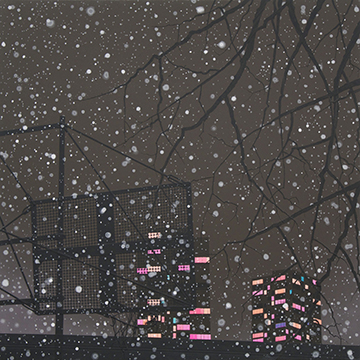Erik Benson makes paintings that are informed by fragments of urban landscape and culture that are found in the everyday. He is particularly attracted to imagery that is ubiquitous within an urban architectonic setting, in which elements of plasticity and temporality are depicted in a suspended state of in-betweeness. It is his intention that these elements incorporate a resonance of a special psycho-geography of place and placelesness that conveys the infrastructure (physically, psychologically, and conceptually) of an urban landscape. An urban sampling of fragment and space, that attempts to express something new about the spaces we inhabit.
Benson is interested in making painting in an analog sense. He builds his paintings by pouring acrylic paint onto sheets of glass. Once the shapes have solidified and acquired elasticity, they are peeled off and collaged into larger compositions. These collaged constructions create a certain mimetic relationship between the images depicted and the processes in which they are made; (primarily notions of production, pre-fabrication, modularity and design.) Similar visual examples and references are toys such as Legos and Colorforms. These applications allow the collaged imagery to portray an analog cartography of constructed spaces and make mark making a reflexive gesture of abstraction by physically controlling how the images in the paintings are built and deleted.
In his current work, he is interested in how space is inhabited. Most of these spaces tend to mimic the processes that go into the making of the work, and highlight a certain dislocation that he finds in the contemporary landscape. Although there are no people in the work there is an acute presence, which portrays the psycho-cartography of our daily lives, why we live where we live, the choices we make, where we go and what we see, and how we move through the day.

